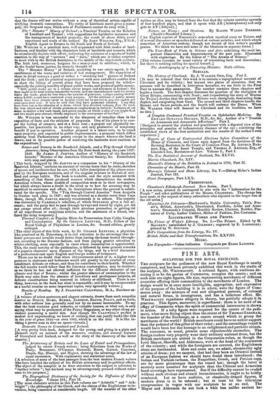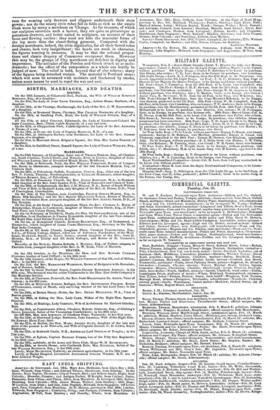FINE ARTS.
SCULPTURE FOR THE ROYAL EXCHANGE.
THE sculpture for the pediment of the new Royal Exchange is nearly completed, and has been privately exhibited this week in the studio of the sculptor, Mr. Wwsrmacorr. A colossal figure, with emblems de- noting it to be the genius of Commerce, occupies the Centre; and on each side are eight figures, life size, representing merchants of different countries offering their commodities to the merchants of London. The design would be at once more intelligible, appropriate, and expressive of the purpose of the building it is to adorn, were the figure of Com- merce away : the mixture of real and allegorical persons, of colossal and natural forms, is incongruous, and has a ludicrous effect. Mr. WEsrmAcorr repudiates allegory. in theory, bat partially adopts it in practice. This figure, moreover, u: superfluous : there is no need of an effigy of Commerce when the spirit of commercial intercourse is shown in action. If a lofty figure were required for the centre of the pedi- ment, what more fitting object than the statue of Sir Tames GRESHAM, the founder of the Exchange, as a centre around which to group the merchants of the world ? British merchants could have no nobler support than the pedestal of this pillar of their order ; and the assemblage round it would have been but due homage to an enlightened and patriotic citizen. The costumes, as usual, present some objectionable anomalies. The foreign traders very properly wear their ordinary national dress, but the British merchants are attired in the Corporation-robes, as though the Lord Mayor, Sheriffs, and Aldermen, were at the head of the commerce of the country; and while the foreigners are covered, the Englishmen. alone are bareheaded. Hats and coats are, we admit, abominably ugly articles of dress ; yet we suspect, that had they been an Oriental instead of an European fashion we should have found them introduced : the Indian and Turkish turbans, the Neapolitan, Greek, and Persian caps, are far more picturesque than the round hat; though the latter is scarcely more unsuited for sculpture than the Chinese and Armenian head-coverings here represented. But if the difficulty cannot be evaded without such obvious and absurd inconsistencies, it ought to be boldly combated. Let us have nuclides, or classically-draped figures' if modern dress is to be tabooed ; but at least let the ridiculous compromises in vogue with our sculptors be at an end. The Mayor and Aldermen do not look a whit less tualae ancient he-
roes for wearing only drawers and slippers underneath their state gowns ; nor do the scanty civic robes fall in folds so rich as the ample cloak worn by many a merchant on 'Change. As for trousers, of which our sculptors entertain such a horror, they are quite as picturesque as pantaloon-drawers, and better suited to sculpture, on account of their loose and flowing outline : they need not hide the muscular forms of the leg more than the closer-fitting garment. Compared with the foreign merchants, indeed, the civic dignitaries, for all their furred robes and chains, look very insignificant : the heads are weak in character, the figures wanting in presence. It may be that the colossal propor- tions and classic drapery of Commerce overpower them. However this may be, the groups of City merchants are deficient in dignity and importance. The attitudes of the Persian and Greek struck us as melo- dramatic; but the effect of the composition as a whole can hardly be judged of now. The relief is bold, beyond that of alto relievo ; many of the figures being detached statues. The material is Portland stone ; which will soon be saturated with moisture and blackened by smoke, unless some means be used to repel the wet and soot.



























 Previous page
Previous page